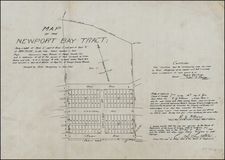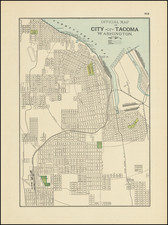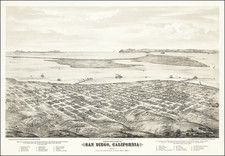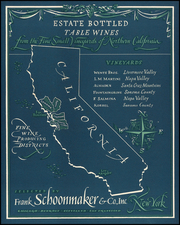"The First Printed Sea Chart of the Northwest Coast of North America" (San Francisco to Vancouver Island)
Rare early sea chart of the Pacific Northwest, from Sir Robert Dudley's Dell'Arcano del Mare.
The chart shows all of the American Pacific coast from San Francisco Bay north to the modern area of Vancouver Island. Several of the California place names, such as Porto di Nueva Albion for the Bay of Sir Francis Drake, are taken from the voyage of Sir Francis Drake. C. Mendocino is clearly marked. Further north, much of the detail is conjectural, as these regions were little known in Dudley’s day. Costa Brava di Quivera is shown.
The map extends north to approximately 50°, which would place the northernmost part of Dudley's chart well north no the Straits of Juan de Fuca, more or less in the center of Vancouver Island. The northernmost placenames on the map are "Costa Incognita" and "C: di Fortuna," well north of the traditional limits of the Island of California and the start of the Straits of Anian.
To the west, a portion of "La Grand Ids di Iezo" (the Great Islands of Japan) suggest a short distance from Japan to the Northwest Coast of America.
Philip Burden describes the map as the
First printed sea chart of the north-west coast of North America, depicting the coastline as far north as 50°. It uses Mercator’s projection for the first time and is the earliest to indicate the prevailing winds and ocean currents. Beautifully engraved by Antonio Francesco Lucini, it records magnetic deviations of the compass. Poto: di Nuoua Albion is located at 38.5° with two legends that record the English visit to the coastline in 1579. It has been suggested that Dudley’s friendship with Sir Francis Drake gave him access to the latter’s papers relating to his landfall in California . . . A descriptive legend near C: Mendocino at 40° states that both Drake and some Spanish pilots found the cape to be at this latitude, but that others believe it to be closer to 50°. . . he strait separating America from Asia is named after Japan, IL STRETTO DE IEZO.
A number of other notes appear in the Pacific, noting the direction of the ocean currents and winds.
This is the first state of the map, without the addition of “Lo.6o” to the title that occurred in the 1661 issue. Burden declares that of the two states, “both are rare, the first being especially so.”
Dudley and the Arcano del Mare
Robert Dudley (1574-1649) is one of the most intriguing historical figures of the late Elizabethan period. His father, also named Robert and the first Earl of Leicester, was a favorite of Elizabeth I's. The Earl was a supporter of exploratory expeditions and backed Francis Drake on his circumnavigation (1577-1580) and Martin Frobisher on his 1576 voyage to find the Northwest Passage. Robert the Younger was the illegitimate son of the Earl and Lady Douglas Sheffield, born in 1574.
Dudley attended Christ Church, Oxford, starting in 1587. A year later, at only 14, Dudley stood by his father at Tilbury, witnessing Queen Elizabeth's famous speech in preparation for resisting the Spanish Armada. His father died in September that year, giving Robert a sizeable inheritance. In 1594, Dudley led an expedition to Guiana, where some of his men explored up the Orinoco River in search of gold. In 1596, Dudley joined an expedition against Cadiz.
All these experiences left Dudley in favor, and he thought the time was right to establish his legitimacy. In court proceedings from 1603 to 1605, Dudley fought for his right to his father's titles, but the Star Chamber ruled against him and he had to left England for self-exile in Italy. He settled in Florence, where he designed and built ships and advised Ferdinand I, Grand Duke of Tuscany.
While in Florence, Dudley also compiled all his sailing notes and thoughts on navigation (and those of others including, purportedly, Francis Drake, with whom he sailed in 1596, and Thomas Cavendish, to whom he was related by marriage) into a work called Arcano del Mare, or The Secret of the Sea. He finished the manuscript of the work in 1636 and published the work himself, at age 73, a decade later in 1646-7. It is there that this chart first appeared; it was reissued in 1661 in this second state.
The chart was compiled and drawn by Dudley, but it was engraved by Anton Francesco Lucini (1610-ca.1661). Lucini, a Florentine, did the engravings for Dudley's entire Arcano del Mare, which remain his most famous works. The fine scrollwork and distinctive style of Dudley's charts are due to Lucini, who spent 12 years and 5,000 pounds of copper in making the 200 plates and 146 charts.
It should be reiterated how important Arcano del Mare is to the history of cartography. It is the first sea atlas published by an Englishman. It is the first sea atlas to cover the entire world, not just the shores of Europe. It is the first to utilize the Mercator projection. This chart was the first to cover New Netherlands and New England in such detail. In short, this chart, and the atlas it originally accompanied, are monuments within the history of hydrography and cartography.
Robert Dudley (1574-1649) is one of the most intriguing historical figures of the late Elizabethan period. His father, also named Robert and the first Earl of Leicester, was a favorite of Elizabeth I’s. The Earl was a supporter of exploratory expeditions and backed Francis Drake on his circumnavigation (1577-1580) and Martin Frobisher on his 1576 voyage to find the Northwest Passage. Robert the Younger was the illegitimate son of the Earl and Lady Douglas Sheffield, born in 1574.
Dudley attended Christ Church, Oxford, starting in 1587. A year later, at only 14, Dudley stood by his father at Tilbury, witnessing Queen Elizabeth’s famous speech in preparation for resisting the Spanish Armada. His father died in September that year, giving Robert a sizeable inheritance. In 1594, Dudley led an expedition to Guiana, where some of his men explored up the Orinoco River in search of gold. In 1596, Dudley joined an expedition against Cadiz.
All these experiences left Dudley in favor, and he thought the time was right to establish his legitimacy. In court proceedings from 1603 to 1605, Dudley fought for his right to his father’s titles, but the Star Chamber ruled against him and he had to leave England for self-exile in Italy. He settled in Florence, where he designed and built ships and advised Ferdinand I, Grand Duke of Tuscany.
While in Florence, Dudley also compiled all his sailing notes and thoughts on navigation (and those of others including, purportedly, Francis Drake, with whom he sailed in 1596, and Thomas Cavendish, to whom he was related by marriage) into a work called Arcano del Mare, or The Secret of the Sea. He finished the manuscript of the work in 1636 and published the work himself, at age 73, a decade later in 1646-7.
Dudley’s Arcano del Mare (Mystery of the Sea) is one of the most important atlases ever produced and one of the most complex. It is the first sea-atlas of the whole world; the first with all the charts constructed using Mercator's new projection, as corrected by Edward Wright; the first to give magnetic declination; the first to give prevailing winds and currents; the first to expound the advantages of Great Circle Sailing; and the first sea-atlas to be compiled by an Englishman, albeit abroad in Italy. Dudley broke completely with the contemporary style of charts. He showed lines of latitude and longitude and omitted all compass lines. In doing so, his purpose was more intellectual than practical: techniques for determining longitude at sea were not refined until more than two centuries later. The maps are by English and other pilots and it is generally accepted that the work was both scientific and accurate for the time. Dudley used the original charts of Henry Hudson, and for the Pacific Coast of America used Cavendish's observations. The Arcano del Mare was a monumental and totally original task; the charts, representations of instruments, and diagrams all engraved on huge quantities of copper over many years with an exactitude incorporating the minutest detail and printed on the best possible paper.
Antonio Francesco Lucini, the engraver, was born in Florence c. 1610. Before being employed by Dudley, he had already engraved views of Florence and scenes of the Turkish Wars. In a printed introductory leaf found in one copy in the British Library, Lucini states that he worked on the plates in seclusion for twelve years in a Tuscan village, using no less than 5,000 lbs (2,268 kg) of copper.

![[San Francisco to British Columbia] Carta particolare dello stretto di Iezo fra l'America e I'Isola Iezo . . . D'America Carta XXXIII By Robert Dudley](https://storage.googleapis.com/raremaps/img/small/67788.jpg)








![[ Hand Drawn Map ] Mexico, California, and Texas](https://storage.googleapis.com/raremaps/img/small/99068.jpg)


![[ Japan ] Royaume du Iapon. Designe par le Pere Ph. Briet de la Compagnie de Iesus . . .](https://storage.googleapis.com/raremaps/img/small/75238.jpg)

